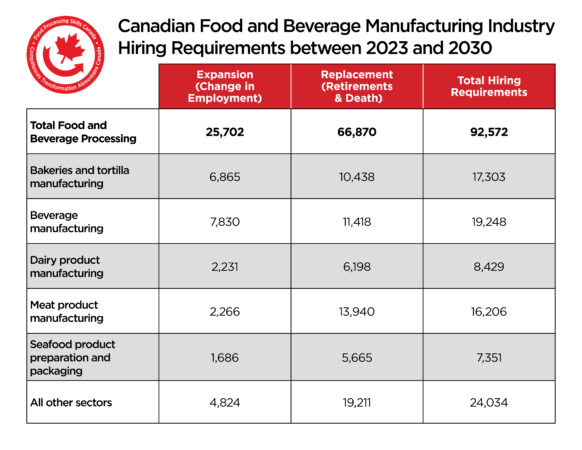
Industry needs 142k new employees
By Jennefer Griffith
Business Operations Editor pick Food Processing Skills Canada human resourcesLatest labour market data sharpens our view of the future
 The Canadian food and beverage industry will need approximately 92,572 new employees over the next seven years. Photo © aicandy / Adobe Stock
The Canadian food and beverage industry will need approximately 92,572 new employees over the next seven years. Photo © aicandy / Adobe Stock Food Processing Skills Canada (FPSC) has been conducting general and subsector analysis of labour market information for the food and beverage manufacturing industry in Canada for many years. The insights have been essential to understanding the labour environment and designing programs and resources that provide support.
Our most recent analysis was just completed. To set the context, we have to remind ourselves that Canada’s aging demographics and falling birth rates have led to a decline in natural population growth (births minus deaths). Natural population growth is anticipated to continue to decline in the coming years.
We also know from previous research that a single unfilled position in the food and beverage processing industry could cost businesses as much as $190 per day in lost net revenue. With over 8,200 businesses across Canada that employ people, losses from job vacancies could total up to a staggering $9.3 million in net revenue per day or $3.4 billion per year.

The Canadian food and beverage manufacturing industry will need 142,000 new people between 2023 and 2030. Image © FPSC
Labour needs
What we have learned over the summer is that as of 2022, the food and beverage manufacturing sector employed approximately 300,000 people and industry employment is expected to reach 325,000 by 2030, an increase of nine per cent.
However, we also know that between 2023 and 2030, 66,870 food and beverage processing employees are expected to retire. Additionally, 25,702 new employees will be needed due to projected growth in the sector. This means the industry has a base requirement of 92,572 new employees over the next seven years or approximately 30 per cent of the current workforce. There is even more to the story because we must also include in the calculation the current 50,000 vacancies that remain unfilled. In total, the Canadian food and beverage manufacturing industry will need 142,000 new people between 2023 and 2030.
Overall, we predict that labour productivity will rise by 2.7 per cent between now and 2030 across all sectors except beverage manufacturing. This lack of productivity is due to the breweries subsector, which has 300 more employer establishments today than it did five years ago.
Beverage manufacturing also has the highest demand for new people, both in terms of numbers and percentage, with the sector requiring 19,000 new people by 2030 or 38.5 per cent of their current workforce.
We found that the meat and poultry processing sector is much more stable with the hiring projection only accounting for 25 per cent of the current workforce, or five per cent below the 30 per cent for all of food and beverage processing. In the seafood processing sector, we found the oldest workforce and the highest percentage demand to replace retiring workers with 28 per cent of its current workforce expected to retire by 2030. The retirement demand accounts for 77 per cent of seafood’s total hiring projections.
So how do we address the forecasted demand of 142,000 people by 2030 across the Canadian food and beverage manufacturing industry?
The immigration opportunity
First, we have to start by looking to new Canadians. Canada is welcoming 1.2 million newcomers between 2021 to 2023. Immigrants already represent 31 per cent of the industry’s workforce, which is a few points higher than the general labour force in Canada.
From surveying, we have learned that 44 per cent of manufacturers are making a concerted effort to recruit newcomers. Many already use the Temporary Foreign Worker Program and have dedicated programs to recruit and train immigrants, including refugees.
Compared to the average Canadian resident, newcomers face higher rates of underemployment and unemployment, are more highly motivated to look for employment opportunities, and are more interested in taking a job in food and beverage processing. Projections also tell us that if current trends continue, by 2041 half of the Canadian population will be made up of immigrants and their Canadian-born children. Immigration is an opportunity for everyone.
Jennefer Griffith is the executive director of Food Processing Skills Canada.
This article was originally published in the October 2023 issue of Food in Canada.
Print this page